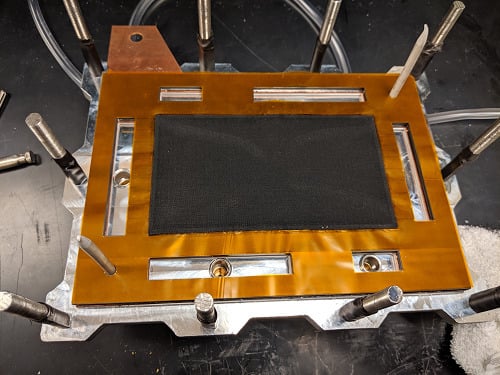Prediction of Performance Variation Caused by Manufacturing Tolerances and Defects in Gas Diffusion Electrodes of Phosphoric Acid (PA)–Doped Polybenzimidazole (PBI)-Based High-Temperature Proton Exchange Membrane Fuel Cells
Abstract
1. Introduction
2. Mathematical Model
3. Results and Discussion
3.1. Baseline Performance of MEAs
3.2. Study of Agglomerate Distribution or Uncoated Regions in the Cathode Catalyst Layer That Would Cause a 10% Drop in Performance
3.3. Sensitivity Analysis for the Defect Location
3.4. Sensitivity Analysis for GDE Porosity
4. Conclusions
Author Contributions
Funding
Conflicts of Interest
Appendix A
Appendix A.1. Transport Equations in the Flow Field
Appendix A.1.1. Mass Transport
Appendix A.1.2. Momentum Conservation
Appendix A.1.3. Conservation of Chemical Species
Appendix A.2. Transport Equations in the Ionomer (PA)-Phase
Conservation of Charge
Appendix A.3. Constitutive Relations
Appendix B
Appendix B.1. Nomenclature
| Aact | active area of catalyst layer (cm2) |
| effective catalyst surface area per unit volume (cm2/cm3) | |
| ad | catalyst area with defects per unit volume (cm2/cm3) |
| constant in Slattery–Bird correlation (A25) | |
| b | Tafel slope (V/decade) |
| exponent in Slattery–Bird correlation (A25) | |
| D | diffusion coefficient (m2/s) |
| Dij | binary diffusion coefficient (m2/s) |
| equilibrium potential (V) | |
| F | Faraday constant 96487 (C/mols H+) |
| reference exchange current density (A/m2) | |
| current density (A/cm2) | |
| j | charge transfer current (A/cm3) |
| absolute viscous permeability (cm2) | |
| mass source (g/cm3s) | |
| n | number of defects |
| pressure (Pa) | |
| t | time (s) |
| tcl | thickness of catalyst area (mm) |
| temperature (K) | |
| velocity vector (cm/s) | |
| V | volume of catalyst layer (m3) |
| Vd | volume of defects in catalyst layer (m3) |
| V1d | volume of a single defect (mm) |
| molecular weight (g/mols) | |
| mass fraction of chemical species |
Appendix B.2. Greek Symbols
| surface porosity | |
| directional surface permeability of ionomer | |
| volumetric porosity | |
| activation polarization (V) | |
| electrochemical reaction rate at cathode (mols/cm3s) | |
| density (g/cm3) | |
| viscosity (Ns/cm2) | |
| stoichiometric coefficient | |
| ionomer conductivity | |
| potential (V) |
Appendix B.3. Subscripts
| a | anode |
| c | cathode |
| cr | critic |
| i | chemical species i |
| i | ionomer (PA)-phase |
| s | solid (electrically-conductive)-phase |
Appendix B.4. Superscripts
| a | anodic |
| c | cathodic |
References
- Schmidt, T.J. High-Temperature Polymer Electrolyte Fuel Cells: Durability Insights. In Polymer Electrolyte Fuel Cell Durability; Buchi, F.N., Inaba, M., Schmidt, T.J., Eds.; Springer: New York, NY, USA, 2009; pp. 199–221. [Google Scholar]
- Wasmus, S.; Valeriu, A.; Mateescu, G.D.; Tryk, D.A.; Savinell, R.F. Characterization of H3P04-Equilibrated Nafion® 117 Membranes Using 1H and 31p NMR Spectroscopy. Solid State Ion. 1995, 80, 87–92. [Google Scholar] [CrossRef]
- Savinell, R.F.; Litt, M.H. Proton Conducting Polymers Used as Membranes. U.S. Patent 5,525,436, 11 June 1996. [Google Scholar]
- Wang, J.T.; Savinell, R.F.; Wainright, J.S.; Litt, M.H.; Yu, H. A H2/O2 Fuel Cell Using Acid Doped Polybenzimidazole as Polymer Electrolyte. Electrochim. Acta 1996, 41, 193–197. [Google Scholar] [CrossRef]
- Savinell, R.; Yeger, E.; Tryk, D.; Landau, U.; Wainright, J.; Weng, D.; Lux, K.; Litt, M.; Rogers, C. A Polymer Electrolyte for Operation at Temperatures up to 200 °C. J. Electrochem. Soc. 1994, 141, L46–L48. [Google Scholar] [CrossRef]
- Weng, D.; Wainright, J.S.; Landau, U.; Savinell, R.F. Electro-osmotic Drag Coefficient of Water and Methanol in Polymer Electrolytes at Elevated Temperatures. J. Electrochem. Soc. 1996, 143, 1260–1263. [Google Scholar] [CrossRef]
- Sammes, S.R.; Wasmus, S.; Savinell, R.F. Thermal Stability of Proton Conducting Acid Doped Polybenzimidazole in Simulated Fuel Cell Environments. J. Electrochem. Soc. 1996, 143, 1225–1232. [Google Scholar] [CrossRef]
- Wainright, J.S.; Litt, M.H.; Savinell, R.F. High-Temperature Membranes. In Handbook of Fuel Cells. Fundamentals, Technology and Applications; Vielstich, W., Lamm, A., Gasteiger, H.A., Eds.; John Wiley & Sons: New York, NY, USA, 2003; Volume 3, p. 436. [Google Scholar]
- Xiao, L.; Zhang, H.; Scanlon, E.; Ramanathan, L.S.; Choe, E.-W.; Rogers, D.; Apple, T.; Beniecewicz, B.C. High-Temperature Polybenzimidazole Fuel Cell Membranes via a Sol-Gel Process. Chem. Mater. 2005, 17, 5328–5333. [Google Scholar] [CrossRef]
- Xiao, L.; Zhang, H.; Scanlon, E.; Chen, R.; Choe, E.-W.; Ramanathan, L.S.; Yu, S.; Beniecewicz, B.C. Synthesis and Characterization of Pyridine-Based Polybenzimidazoles for High Temperature Polymer Electrolyte Membrane Fuel Cell Applications. Fuel Cells 2005, 5, 287–295. [Google Scholar] [CrossRef]
- Schmidt, T.J.; Baurmeister, J. Properties of High-Temperature PEFC Celtec®-P 1000 MEAs in Start/Stop Operation Mode. J. Power Sourcce 2008, 176, 428–434. [Google Scholar] [CrossRef]
- Uchida, M.; Aoyama, Y.; Eda, N.; Ohta, A. Investigation of the Microstructure in the Catalyst Layer and Effects of Both Perfluorosulfonate Ionomer and PTFE-Loaded Carbon on the Catalyst Layer of Polymer Electrolyte Fuel Cells. J. Electrochem. Soc. 1995, 142, 4143–4149. [Google Scholar] [CrossRef]
- Watanabe, M.; Igarashi, H.; Yosioka, K. An experimental prediction of the preparation conditions of Nafion-coated catalyst layers for PEFCs. Electrochim. Acta 1995, 40, 329–334. [Google Scholar] [CrossRef]
- Scharifker, B.R.; Zelenay, P.; Bockris, J.M. The Kinetics of Oxygen Reduction in Molten Phosphoric Acid at High Temperatures. J. Electrochem. Soc. 1987, 134, 2714–2725. [Google Scholar] [CrossRef]
- Haug, A.T.; White, R.E. Oxygen Diffusion Coefficient and Solubility in a New Proton Exchange Membrane. J. Electrochem. Soc. 2000, 147, 980–983. [Google Scholar] [CrossRef]
- Cheddie, D.F.; Munroe, N.D. A Two-Phase Model of an Intermediate Temperature PEM Fuel Cell. Int. J. Hydrogen Energy 2007, 32, 832–841. [Google Scholar] [CrossRef]
- Siegel, C.; Bandlamudi, G.; Heinzel, A. Numerical Simulation of a High-Temperature PEM (HTPEM) Fuel Cell. In Proceedings of the COMSOL Users Conference 2007, Grenoble, France, 23–24 October 2007. [Google Scholar]
- Siegel, C.; Bandlamudi, G.; Heinzel, A. Modeling Polybenzimidazole/Phosphoric Acid Membrane Behavior in a HTPEM Fuel Cell. In Proceedings of the COMSOL Conference 2008, Hannover, Germany, 4–6 November 2008. [Google Scholar]
- Hu, J.; Zhang, H.; Gang, L. Diffusion-Convection/Electrochemical Model studies on Polybenzimidazole (PBI) Fuel Cell Based on AC Impedance Technique. Energy Convers. Manag. 2008, 49, 1019–1027. [Google Scholar] [CrossRef]
- Gurau, V.; Zawodzinski, T.A.; Mann, J.A. Two-Phase Transport In PEM Fuel Cell Cathodes. J. Fuel Cell Sci. Technol. 2008, 5, 021009. [Google Scholar] [CrossRef]
- Gurau, V.; Edwards, R.V.; Mann, J.A.; Zawodzinski, T.A. A Look at the Multiphase Mixture Model for PEM Fuel Cell Simulations. Electrochem. Solid-State Lett. 2008, 11, B132–B135. [Google Scholar] [CrossRef]
- Gurau, V.; Zawodzinski, T.A.; Mann, J.A. Spatiotemporal Behavior of Water and Two-Phase Transport in the Porous Electrodes for PEM Fuel Cells. Characterization of Porous Materials 2. ECS Trans. 2009, 19, 29–38. [Google Scholar]
- Gurau, V.; Mann, J.A. A Critical Overview of Computational Fluid Dynamics Multiphase Models for Proton Exchange Membrane Fuel Cells. SIAM J. Appl. Math. 2009, 70, 410–454. [Google Scholar] [CrossRef]
- Gurau, V.; Mann, J.A. A Continuum Model for Water Transport in the Ionomer-Phase of Catalyst Coated Membranes for PEMFCs. Adv. Mech. Eng. 2010, 2010, 372795. [Google Scholar] [CrossRef]
- Gurau, V.; Mann, J.A. Effect of Interfacial Phenomena at the Gas Diffusion Layer-Channel Interface on the Water Evolution in a PEM Fuel Cell. J. Electrochem. Soc. 2010, 157, B512–B521. [Google Scholar] [CrossRef]

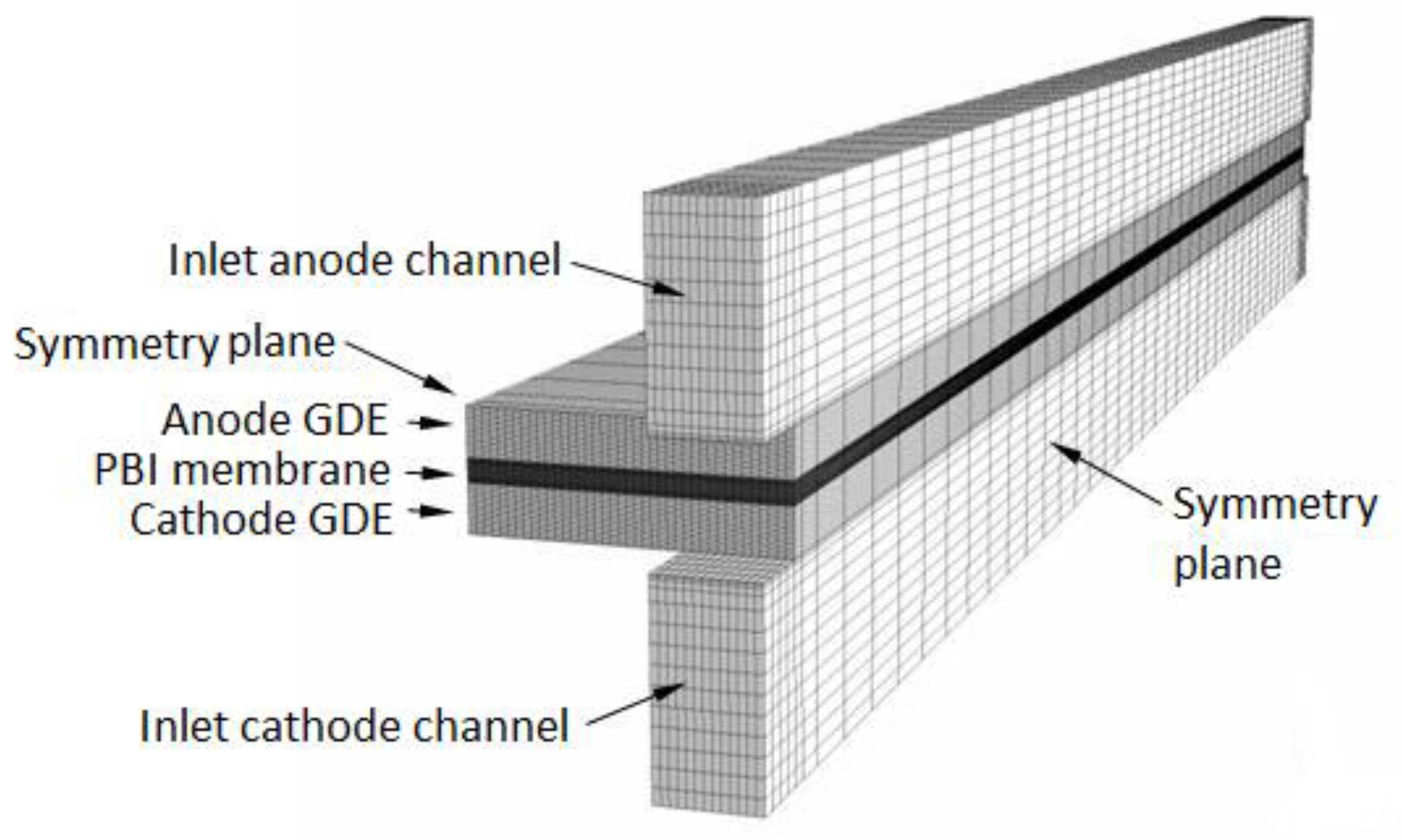
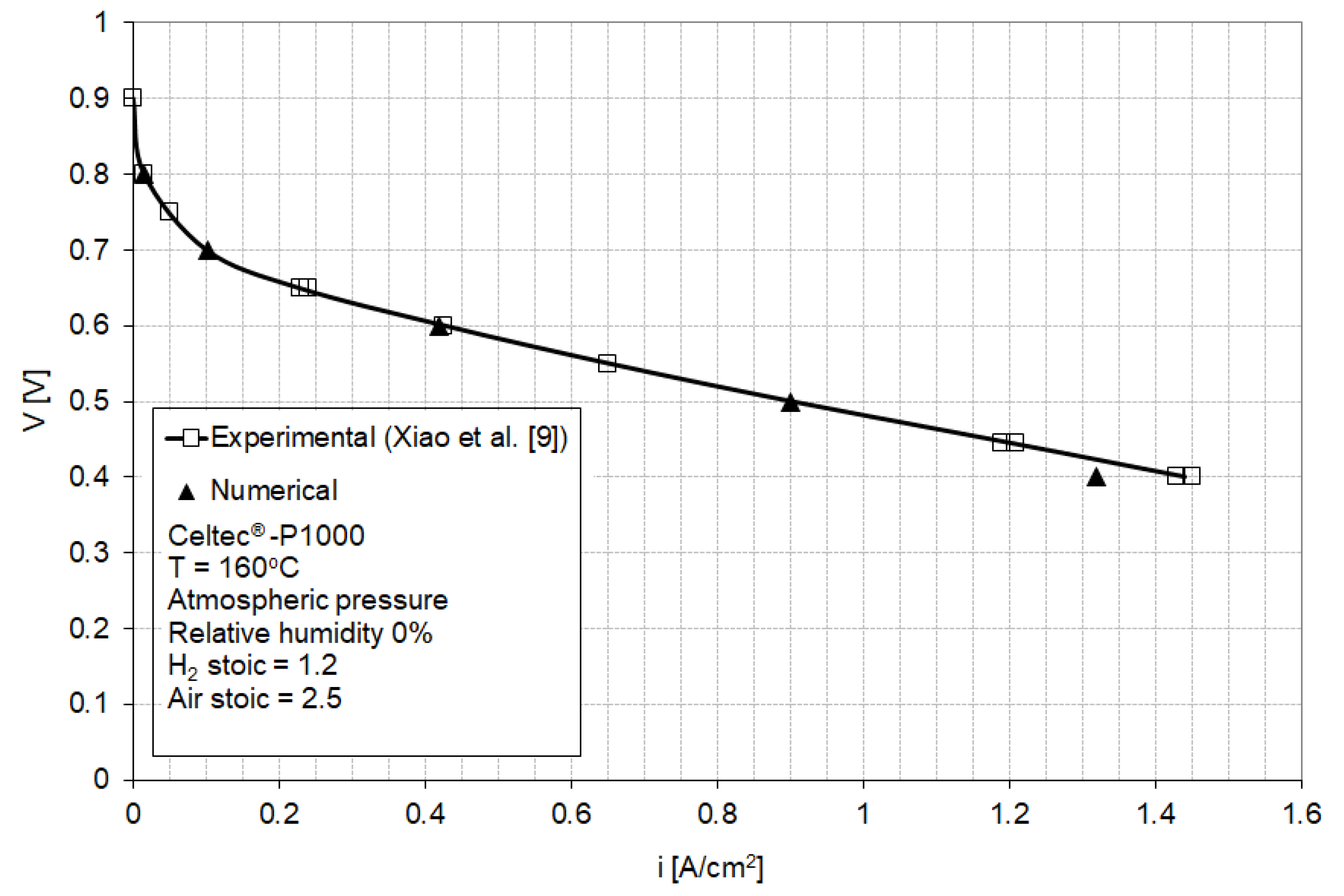

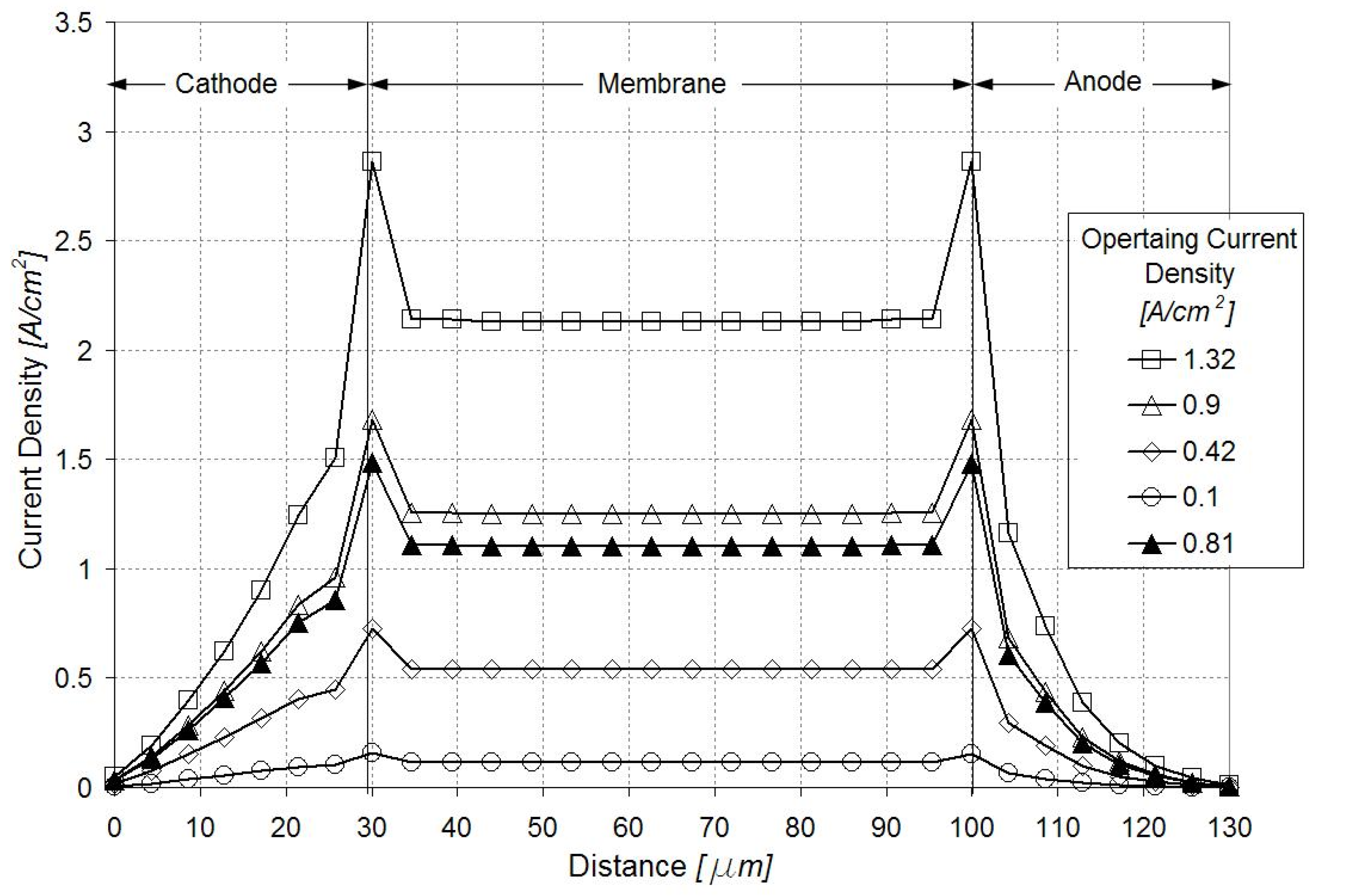

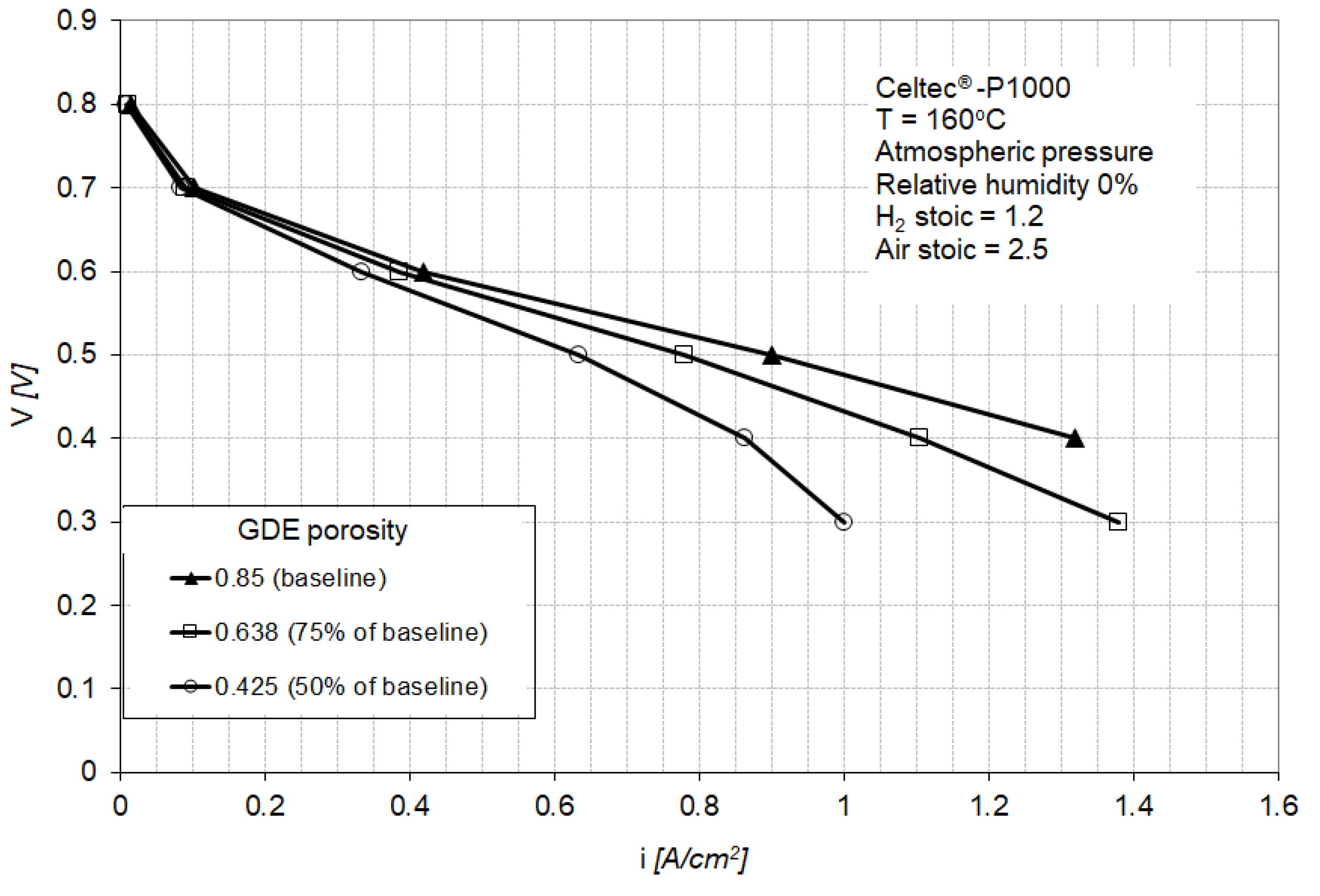

| Parameter | Model | Measured |
|---|---|---|
| Tafel slope for oxygen reduction reaction, b | 86 mV/decade | 90 mV/decade (Reference [11]) |
| Equilibrium potential, Eeq | 1.15 V | - |
| Reference exchange current density x effective catalyst area/unit volume, | 5.5 × 10−4 A/cm2 | - |
| Membrane conductivity, | 0.135 S/cm | 0.225 S/cm (Reference [9]) |
| Reference Exchange Current Density X Effective Catalyst Area/Unit Volume, (A/cm2) × 10−4 | Volume of Defects, Vd % of Total Catalyst Volume | Number of Defects/cm2 in Catalyst Active Area | |
|---|---|---|---|
| Pristine catalyst layer | 5.5 | 0% | 0 |
| Catalyst layer causing 10% performance reduction | 3.35 | 39% | 46.6 × 106 |
| Defect Location from Membrane/Catalyst Layer Interface, % of Catalyst Layer Thickness | Change in Local Current Density, % of Current in Pristine GDE | |
|---|---|---|
| Region 1 in Figure 4 | Region 2 in Figure 4 | |
| 7 | 1.6 | 1.6 |
| 36 | 0.6 | 1.1 |
| 64 | 0.4 | 0.1 |
| 93 | 0.3 | 0.0 |
© 2020 by the authors. Licensee MDPI, Basel, Switzerland. This article is an open access article distributed under the terms and conditions of the Creative Commons Attribution (CC BY) license (http://creativecommons.org/licenses/by/4.0/).
Share and Cite
Gurau, V.; De Castro, E.S. Prediction of Performance Variation Caused by Manufacturing Tolerances and Defects in Gas Diffusion Electrodes of Phosphoric Acid (PA)–Doped Polybenzimidazole (PBI)-Based High-Temperature Proton Exchange Membrane Fuel Cells. Energies 2020, 13, 1345. https://doi.org/10.3390/en13061345
Gurau V, De Castro ES. Prediction of Performance Variation Caused by Manufacturing Tolerances and Defects in Gas Diffusion Electrodes of Phosphoric Acid (PA)–Doped Polybenzimidazole (PBI)-Based High-Temperature Proton Exchange Membrane Fuel Cells. Energies. 2020; 13(6):1345. https://doi.org/10.3390/en13061345
Chicago/Turabian StyleGurau, Vladimir, and Emory S. De Castro. 2020. "Prediction of Performance Variation Caused by Manufacturing Tolerances and Defects in Gas Diffusion Electrodes of Phosphoric Acid (PA)–Doped Polybenzimidazole (PBI)-Based High-Temperature Proton Exchange Membrane Fuel Cells" Energies 13, no. 6: 1345. https://doi.org/10.3390/en13061345
APA StyleGurau, V., & De Castro, E. S. (2020). Prediction of Performance Variation Caused by Manufacturing Tolerances and Defects in Gas Diffusion Electrodes of Phosphoric Acid (PA)–Doped Polybenzimidazole (PBI)-Based High-Temperature Proton Exchange Membrane Fuel Cells. Energies, 13(6), 1345. https://doi.org/10.3390/en13061345





